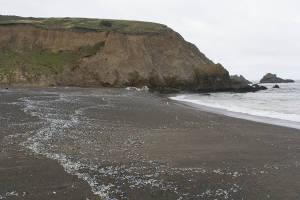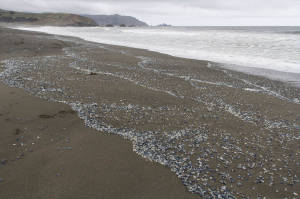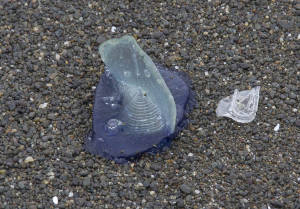Snowy Plover & Velella Velella by Paul Donahue
Several of us got together to participate in the census of Snowy Plovers that is conducted twice annually along the Pacific Coast from Washington to Baja. Our wintering Snowy Plovers left back on March 13th, returning to their nesting beaches, but we covered Pacifica’s three beaches just the same, just to be scientific about it.
While we didn’t find any Snowy Plovers, as expected, we found LOTS of Velella velella or By-the-Wind Sailor, the little Portuguese Man-O-War relative. This has been a HUGE spring for them getting blown ashore on beaches all along the California coast. All of these photos are from Sharp Park Beach. After we walked the beach looking for plovers, we walked it again to do a careful count of the Velella. The total we came up with was 46,389,448,183,037 and that’s not including all of the ones that were sloshing in the surf waiting to be washed up on the beach (JK).
The close-up photo shows an individual that is still in pretty good shape. The clear, vertical, aqua-tinted bit is its little sail, and what dooms it to stranding on the beach. The animals have no control of their direction of travel and just get blown where the wind takes them. If the wind blows long enough from the same direction, eventually they wash up against a shoreline.
One might think that for organisms like Velella that float on the ocean’s surface in areas with consistent winds blowing from the same direction, like California’s persistent NW winds in spring, a fixed sail would be a serious evolutionary disadvantage – and the evidence would seem to back up that hypothesis. To me, the amount of waste seems unsupportable. These photos show only one day on one beach, but this stranding has been going on for over a month now all along the California coast. How many billions of these poor creatures have washed ashore? How many more are out there? How can the species survive these sorts of losses? Why would it evolve such a sail when these massive strandings are the result?
Post Author: Paul Donahue



